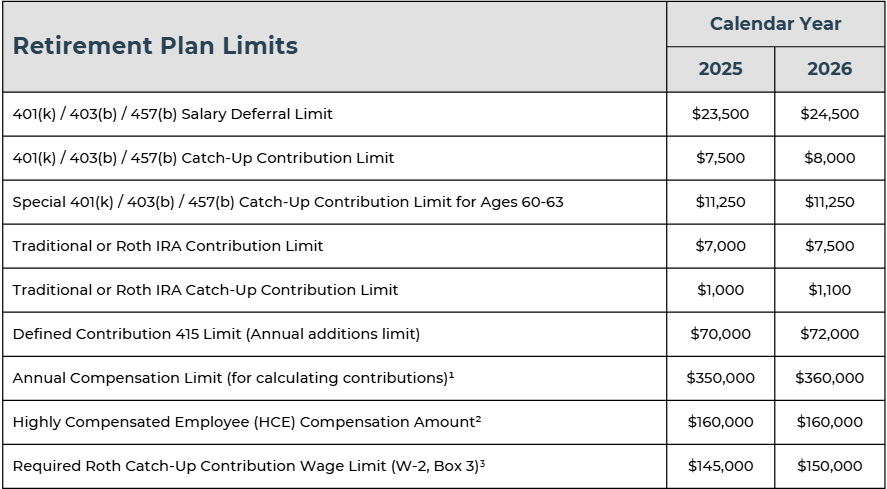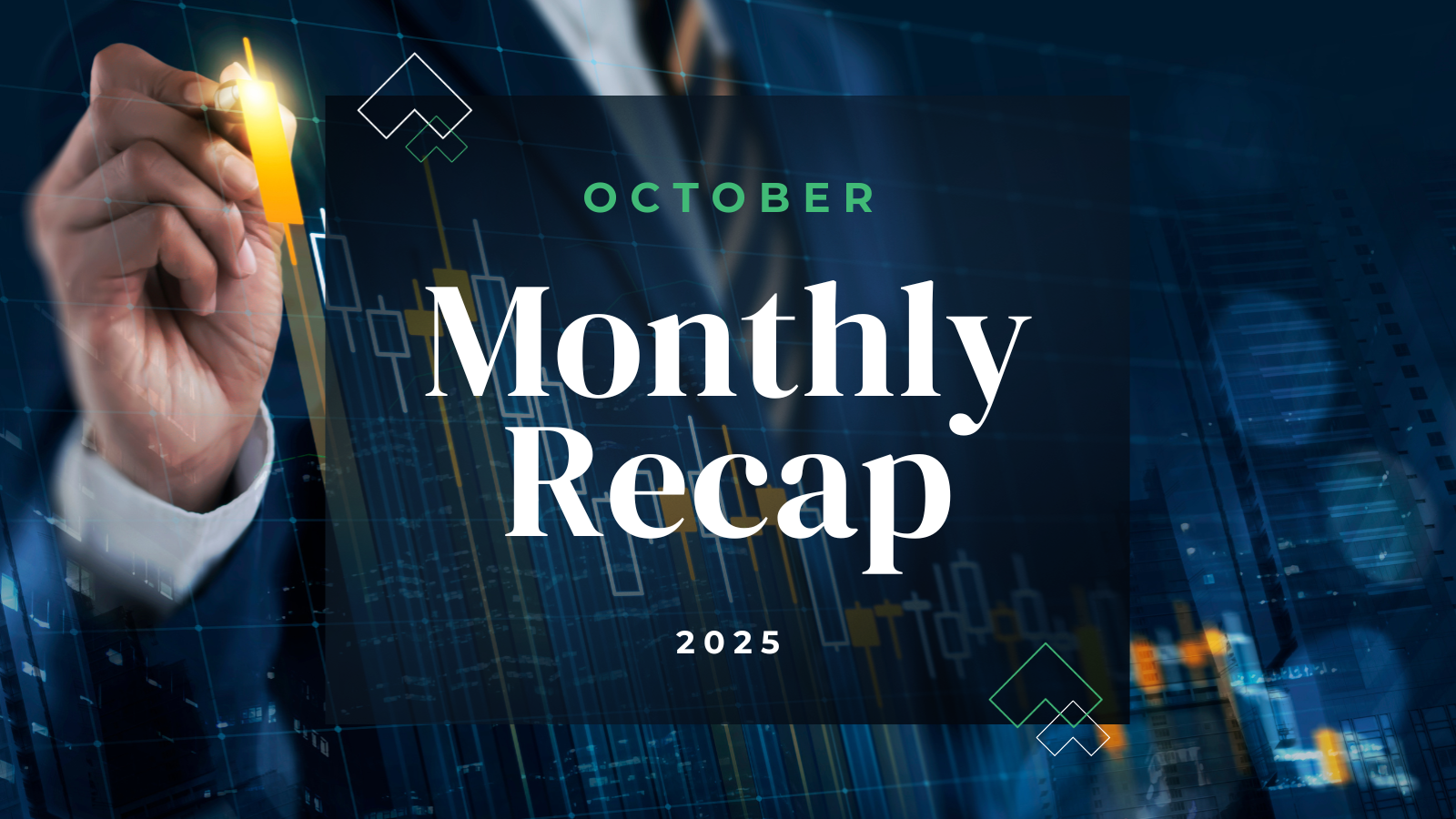By Sarah Bishop, Senior Retirement Plan Advisor – Learn more about our Retirement Plan Consulting Services
The Internal Revenue Service (IRS) announced increases to retirement plan limits for tax year 2026. These cost-of-living adjustments were published on Thursday, November 13, 2025. These new limits provide workers with an opportunity for greater savings next year.
In 2026, workers can contribute $24,500 pre-tax to a 401(k) or similar retirement savings plan – a $1,000 increase from 2025. Workers aged 50 or older can also contribute $8,000 in catch-up contributions in 2026, a $500 increase from 2025.
If permitted under the employer’s 401(k), 403(b), or governmental 457(b) plan, the special catch-up limit for participants aged 60-63 will be $11,250 for 2026. This remains unchanged from 2025.
Important Update:
Beginning with the 2026 plan year, the SECURE 2.0 Act’s Roth Catch-Up Contribution provision takes effect. Participants eligible for catch-up contributions (those age 50 or older by year-end) who earned more than $150,000 in FICA wages (Box 3 of Form W-2) from their current employer in 2025, will be required to make those contributions on a Roth (after-tax) basis.

1 Limit applies for plan years beginning with or within the calendar year.
2 Compensation limit applies to employees who earned more than the amount listed in the previous calendar year, and if elected by the employer for the plan year, was in the top-paid 20% for the previous year.
3 Compensation limit applies to employees who earned more than the amount listed in the previous calendar year
What Does This Mean for You?
If you already maximize your annual contributions and have the ability to save more, you may be able to lower your taxable income by $1,000 in 2026. If you will attain age 50 in 2025, don’t forget that you’re eligible for the catch-up contribution, an additional $8,000 savings opportunity.
While only pre-tax contributions reduce your current tax burden, the increased limits also apply to Roth contributions.
Limits for other types of retirement plans will vary. See IRS Notice 2025-67 for details.
What Does the Special Catch-up Provision Mean for You?
If you will attain age 60, 61, 62, or 63 during 2026, and your employer offers the additional catch-up under SECURE 2.0, you will be eligible to save an additional $3,250 above the regular catch-up limit ($11,250 in total catch-up).
How Do the Changes in Limits Impact Individual Retirement Accounts (IRAs)?
For those eligible to make contributions to a pre-tax or Roth IRA, the limit is $7,500 for 2026 – a $500 increase from 2025. The age 50 catch-up contribution in these accounts is $1,100 – a $100 increase from 2025.
Is There a Compensation Limit Associated with These Changes?
The compensation limit for 401(k) or similar retirement savings plans will increase from $350,000 to $360,000. If your income is above this level and your plan matches a percentage of pay, you may also see a greater dollar amount in employer matching contributions for 2026.
Make sure to adjust your payroll deduction in January 2026 to ensure that you are taking advantage of the increased limits.
What Other Changes are Included?
Increases for Health Savings Accounts (HSA) will also take effect in 2026. See the table below for a summary.

Are You a Business Owner Without a Retirement Plan?
Small employers are eligible for enhanced tax credits to offset start up costs associated with sponsoring a retirement plan for their employees.
Employers with 100 or fewer employees may be eligible to claim up to $5,000* in start up tax credits for 3 years when establishing a new retirement plan.
You may also be eligible to claim tax credits up to $1,000* per employee to offset the costs of employer match or profit sharing contributions for 5 years when establishing a new defined contribution retirement plan.
A $500 tax credit is also available for 3 years for including an automatic enrollment provision in your plan.
*Tax credits are calculated based on the number of eligible non-highly compensated employees.
As a business owner, investing in the financial wellness of your workforce is a strategic decision that can directly influence productivity, employee turnover, healthcare costs, and the overall success of your business.
Visit the Finerty Retirement Plan Team’s Wisdom and Wealth webpage to see how Moneta can help with financial wellness and retirement plan education.
Sources:
Internal Revenue Service –
https://www.irs.gov/pub/irs-drop/n-25-67.pdf
American Retirement Association –
© 2025 Advisory services offered by Moneta Group Investment Advisors, LLC, (“MGIA”) an investment adviser registered with the Securities and Exchange Commission (“SEC”). MGIA is a wholly owned subsidiary of Moneta Group, LLC. Registration as an investment adviser does not imply a certain level of skill or training. The information contained herein is for informational purposes only, is not intended to be comprehensive or exclusive, and is based on materials deemed reliable, but the accuracy of which has not been verified. Trademarks and copyrights of materials referenced herein are the property of their respective owners. Index returns reflect total return, assuming reinvestment of dividends and interest. The returns do not reflect the effect of taxes and/or fees that an investor would incur. Examples contained herein are for illustrative purposes only based on generic assumptions. Given the dynamic nature of the subject matter and the environment in which this communication was written, the information contained herein is subject to change. This is not an offer to sell or buy securities, nor does it represent any specific recommendation. You should consult with an appropriately credentialed professional before making any financial, investment, tax or legal decision. An index is an unmanaged portfolio of specified securities and does not reflect any initial or ongoing expenses nor can it be invested in directly. Past performance is not indicative of future returns. All investments are subject to a risk of loss. Diversification and strategic asset allocation do not assure profit or protect against loss in declining markets. These materials do not take into consideration your personal circumstances, financial or otherwise.



